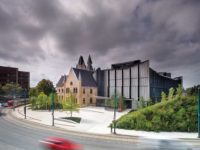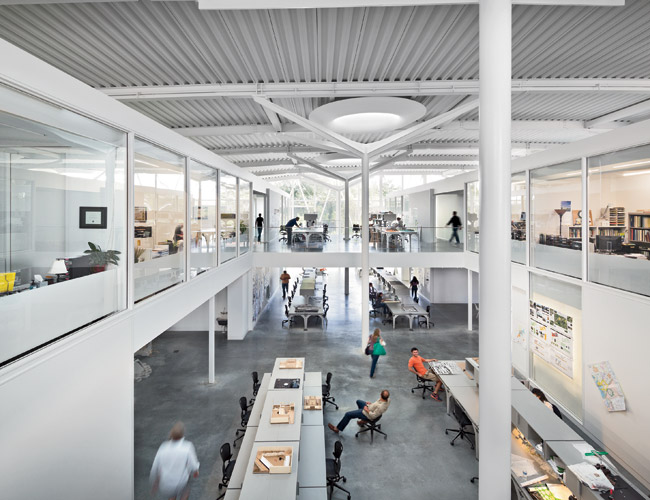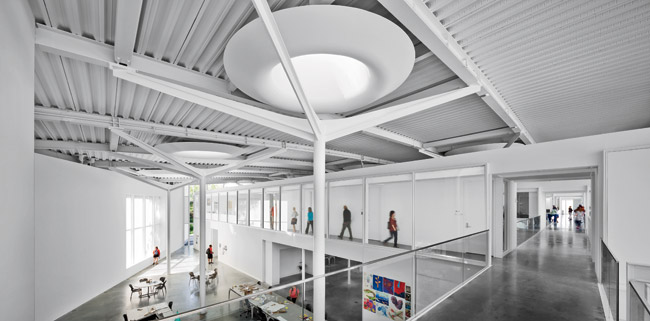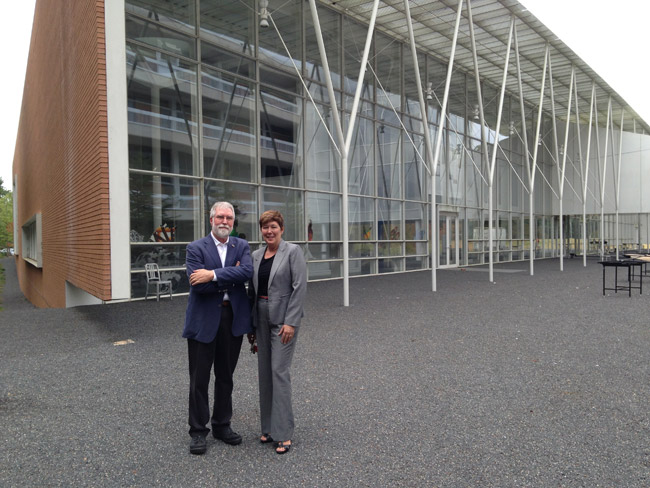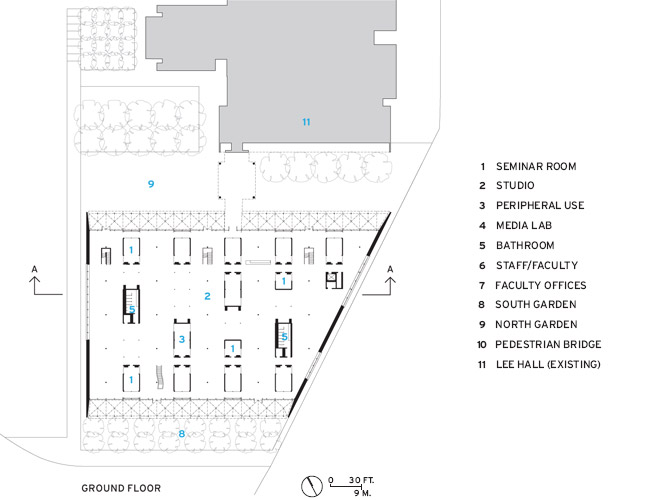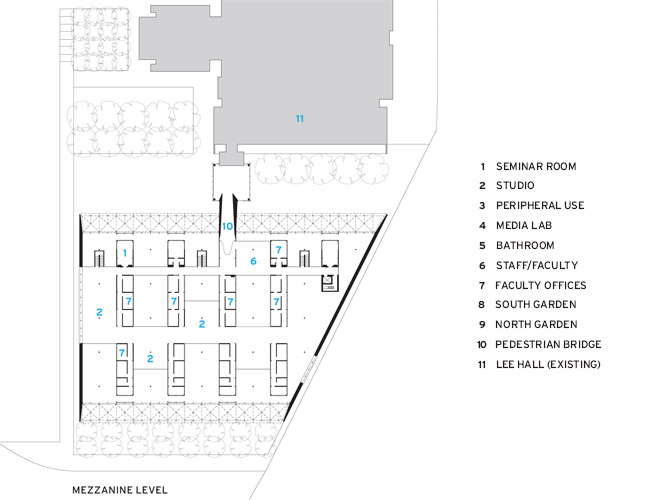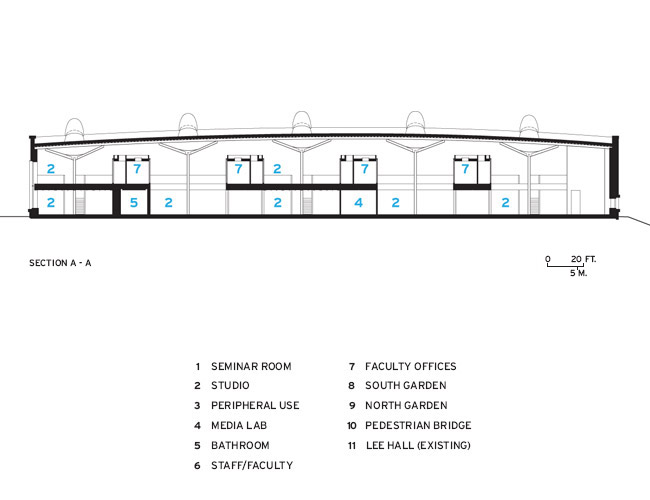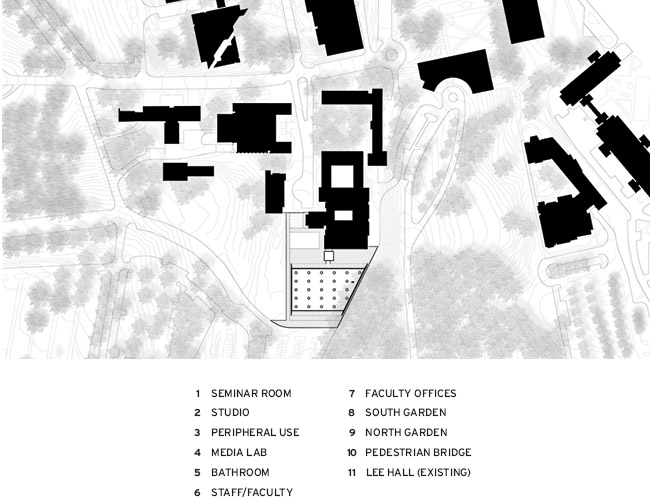Lee Hall Addition, Clemson University
Machine for Learning: An architecture school expands into a steel and glass structure that showcases its structural and energy-efficient features.






























Architects & Firms
Clemson, South Carolina
Architects don’t often get to design a new building for their alma mater. Yet Thomas Phifer, based in New York City, showed it’s possible to go home again—with success. He created an airy 55,000-square-foot addition for the architecture school at Clemson University, in South Carolina, where he got his B.A. in architecture in 1975, and his M.Arch. in 1977. The rural university, founded in 1889 near the Blue Ridge Mountains, is composed of an architectural polyglot of buildings, highlighted by its original Italian Renaissance Revival brick structures. Phifer’s evanescent glass-and-steel pavilion definitely introduces a lighter approach.
A few years ago, Phifer got a call from a former Clemson professor (and graduate), John Jacques, suggesting he go after the commission for the School of Architecture, and related departments: construction science and management; planning, development, and preservation; landscape architecture; and art. Phifer agreed, but not without anxiety. “Since I knew it so well, the idea was really compelling. But,” he adds, with characteristic deference, “I wondered if I was too close to the school to do something effective.”
The $31.6 million project for some 800 students involved restoring and renovating the original Lee Hall (now called Lee I), and a second connected building (Lee II), designed in 1958 and 1975, respectively, each in a Miesian red-brick style by former dean of architecture Harlan McClure. Jacques’s firm, McMillan Pazdan Smith Architecture in Greenville, acted as the associate architect and took charge of the renovation of the older buildings. Besides designing the new addition, Phifer re-skinned a 1990s four-story tower connecting Lee II to Lee III.
During Phifer’s school years he found that the plans of both Lee buildings, organized around open courtyards, encouraged him to learn about related disciplines: “I was a wanderer,” he recalls, “especially late at night, when I walked around to see what was going on in the art studios, building construction areas, and galleries.” But Phifer disliked the way the classrooms and faculty offices were separated from the studios, behind closed doors. “I wanted collective learning—all a mix in a universal space,” he says.
In designing Lee III, Phifer moved the courtyard concept indoors—into the new open, hangar-like hall, which soars to about 31 feet at the center of a gently arcing roof. He divided the indoor area into five bays of studios, partitioned by four double-level glass-and-steel bars for faculty offices and seminar rooms. Additional studios sit on open trays on the mezzanine level, connected by walkways. Entering from a bridge linking Lee II and Lee III, visitors look out and down to studios and student-review areas in this thrumming hub of activity.
Owing to the glazed walls and 25 skylights in the roof (along with additional internal skylights and windows), natural illumination permeates the space even on cloudy days. (Rather bald fluorescent fixtures supplement daylight when necessary). The central architectural feature is the grid of slender, treelike steel columns, 10 ¾ inches in diameter, made from oil-pipe sections. Near the ceiling, four branches extend outward from each column, seemingly to embrace donut-shaped coffers. These fiberglass rings, dematerialized by light filtering down from the glazed oculi, offer a mannerist-modern inversion of the classical notion of solid capitals crowning columns.
Outside, tall porches, shielded by corrugated steel-mesh canopies and supported by slender Y-shaped steel columns, extend 255 feet along the north elevation and 180 feet on the south. For the curtain wall, the design team used 6-inch-square steel elements with pretensioned cables to provide elegant bracing for the fritted double-paned glass. The filigree of structural elements almost appears custom-made. “Yet it’s just all steel—structural deck, plates, and pipes—ordinary elements put together thoughtfully,” says the structural engineer for project, Dmitri Jajich of Skidmore Owings & Merrill (which often works with Phifer on his projects). The interior finishes, including the concrete floors, the roof deck, and the frame, reveal themselves with anatomical precision. “The building functions as a tool for learning,” says Katherine Schwennsen, chair of the architecture school.
The education-by-architecture theme continues to the sloping roof, topped with 30,000 square feet of sedum in 12 inches of engineered soil to mitigate the heat-island effect. Here Phifer protected the skylights with fixed conical “shrouds” that modulate light entering the LEED Gold–certified building—a variation on his skylights at Rice. Geothermal wells (46 in all) provide the energy for radiant heating—and cooling—in the concrete floor and the concrete-over-steel deck of the mezzanine. Passive ventilation brings in fresh air via automated transom windows installed above manually operated ones.
The light-filled, energy-efficient volume, opened in 2012, is just Phifer’s first for Clemson’s 20,000-student campus. In time, he will add a visual arts building bridging the ravine on the east to connect Lee III’s courtyard to an existing performing arts center. When these plans go forward, he’ll go home yet again.
People
Owner:
Architect:
Personnel in architect's firm
Associate architect(s:)
Engineer(s):
Structure:
MEPF:
Environmental:
Landscape:
Lighting:
Exterior Envelope:
Signage:
General contractor:
Photographer:
Renderer:
CAD system, project management, or other software used: Size: 55,000 square feet (gross) Cost: $24 million (new addition) Completion date: February 2012 |
Products
Structural system
Steel Frame Fabrication:
Steel Frame Erection:
Ornamental Metal:
Exterior cladding
Metal Panels:
Installation:
Metal / glass curtain wall:
Installation:
Moisture barrier:
Roofing
Glazing
Skylights:
Hardware Closers: LCN Exit devices: Schlage Pivots: Rixson
Interior finishes
Installation:
Cabinetwork and custom woodwork:
Paints and stains:
Wall coverings:
Installation:
Solid surfacing:
Furnishings
Lighting
Installation:
Exterior:
Conveyance
Energy |



